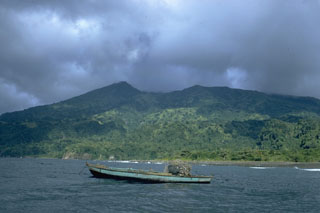Report on Soufriere St. Vincent (Saint Vincent and the Grenadines) — 14 April-20 April 2021
Smithsonian Institution / US Geological Survey
Weekly Volcanic Activity Report, 14 April-20 April 2021
Managing Editor: Sally Sennert.
Please cite this report as:
Global Volcanism Program, 2021. Report on Soufriere St. Vincent (Saint Vincent and the Grenadines) (Sennert, S, ed.). Weekly Volcanic Activity Report, 14 April-20 April 2021. Smithsonian Institution and US Geological Survey.
Soufriere St. Vincent
Saint Vincent and the Grenadines
13.33°N, 61.18°W; summit elev. 1220 m
All times are local (unless otherwise noted)
University of the West Indies Seismic Research Centre (UWI-SRC) and National Emergency Management Organisation (NEMO) reported that the explosive eruption at Soufrière St. Vincent (often simply referred to as “La Soufriere”) continued during 14-20 April, though at a decreasing frequency. Explosions and pyroclastic flows were reported on 13 April, as well as lahars in the Sandy Bay area. During 14 April seismicity continued to be characterized by episodes of tremor, about 13-15 hours apart, separated by swarms of small, long-period (LP) earthquakes. An episode of tremor that began at 1135 was associated with increased explosive activity, though the emissions were gas rich and less energetic than previous events. Another episode of tremor began at 0230 on 15 April along with increased venting. Almost constant swarms of long-period and hybrid events were recorded through the day, punctuated by three brief episodes (less than 30 minutes) of low-level tremor. An episode of tremor began at 2100 and lasted 40 minutes, and was possibly associated with a minor increase in venting. For the first time sulfur dioxide emissions were successfully measured by ground-based instruments; scientists recorded 809 tons per day from a Coast Guard boat along the W coast.
Periods of tremor and near-constant swarms of LP and hybrid events were recorded on 16 April.
An explosion at 0615 on 16 April generated an ash plume that rose about 8 km (26,200 ft) a.s.l. and drifted W. A three-minute period of high-level tremor started at the same time and was flowed by over two hours of lower-level tremor. Sulfur dioxide emissions were again measured from the W coast, yielding a flux of 460 tons per day. The rate of LP and hybrid events dropped significantly at 2000. Sulfur dioxide plumes reached India.
Occasional satellite images of the summit showed a series of changes to the new crater, centered in the SW part of the summit crater. By 17 April an Institut de Physique du Globe de Paris scientist reported that the crater was about 900 m N to S, at least 750 m E to W, and about 100 m deep based on RADAR data. Several vents were either visible or inferred from points of emissions. Sulfur dioxide emissions were 232 and 391 tons per day on 17 and 18 April, respectively. A period of high tremor began at 1649 on 18 April. An explosion produced an ash plume that rose to 8 km (26,200 ft) a.s.l. and drifted S and SW. This explosion occurred 52 hours after the last one and was the 30th since the explosive phase started. The period of tremor lasted until about 2100 and was followed by ongoing small LP and hybrid events. The rates of those events dropped again, at around 0100 on 19 April. One rockfall was detected by the seismic network at 0139, and two were noted the next day. At 0400 on 20 April a lahar was detected by the seismic network and lasted for 30 minutes; it possibly traveled down the SE flank.
During 15-19 April NEMO reported details about the people that have evacuated. The total number of displaced people was 12,775 by 19 April, with 6,208 people in 85 public shelters and 6,567 people (1,800 families) in private shelters. There were no casualties caused by the eruption.
Geological Summary. Soufrière St. Vincent is the northernmost and youngest volcano on St. Vincent Island. The NE rim of the 1.6-km wide summit crater is cut by a crater formed in 1812. The crater itself lies on the SW margin of a larger 2.2-km-wide caldera, which is breached widely to the SW as a result of slope failure. Frequent explosive eruptions after about 4,300 years ago produced pyroclastic deposits of the Yellow Tephra Formation, which cover much of the island. The first historical eruption took place in 1718; it and the 1812 eruption produced major explosions. Much of the northern end of the island was devastated by a major eruption in 1902 that coincided with the catastrophic Mont Pelée eruption on Martinique. A lava dome was emplaced in the summit crater in 1971 during a strictly effusive eruption, forming an island within a lake that filled the crater. A series of explosive eruptions in 1979 destroyed the 1971 dome and ejected the lake; a new dome was then built.
Sources: University of the West Indies Seismic Research Centre (UWI-SRC), National Emergency Management Organisation (NEMO), Government of Saint Vincent and the Grenadines, Advanced geospatial Data Management Platform (ADAM)

